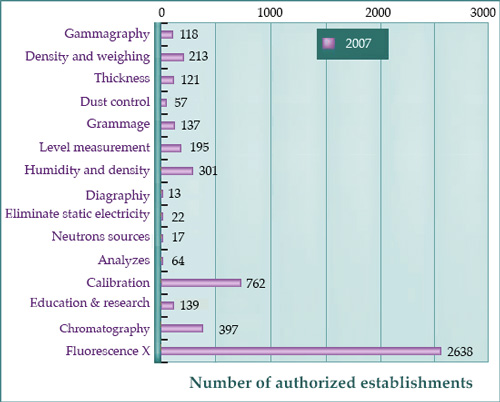A wide variety of applications

Authorizations of radioactive sources by type of application
The applications of radioactive sources in the industry are multiple as shown by the number of establishments authorized to use sealed radioactive sources depending on the type of application. This classification does not distinguish between large and small establishments, which explains why a laboratory technique like X-ray fluorescence seems the most widespread. The table is taken from the 2007 annual report of the french Nuclear Safety Authority.
© ASN
Most radioelements in radioactive sources are extracted from small reactors dedicated to the needs of research, medicine, and industry. Some radioelements are fission products or actinides (americium-241). Others are obtained by irradiation of materials with neutrons (cesium-137, cobalt-60). They are then extracted using radiochemical techniques. When it comes to producing short-lived tracers, especially for medical and research purposes, cyclotrons or accelerators such as the GANIL accelerator in Caen are also used.
The activities of the most commonly sources used in the industry range from a few thousand becquerels (kBq) to a few billions becquerels (GBq).
The main and most common use of radio elements is for « non-destructive testing », that is, for « characterizing materials without compromising their integrity ». these non-destructive checks find applications in:
– Welding control by gammagraphy. True metal x-ray radiography(sources of iridium 192 or cobalt 60)
– Liquid level measurement. The attenuation of the detected signal makes it possible to know the filling level of the container and to automatically trigger certain operations (stop, continue filling, alarm, etc.). The radionuclides and source activities depend on the characteristics of the container and the content: americium 241 (activity 1.7 GBq), cesium-137-barium 137m (activity 37 MBq).
– The measurement of material thicknesses such as paper, fabric, plastic, or sheets, metal plates according to a similar principle and using krypton 85, cesium 137, americium 241, cobalt 60 or prometheus 147 gauges.
– Density and weighing measurement. The principle is similar. The sources used are in general, americium 241 (activity 2 GBq), cesium-baryum 137m (activity 100 MBq) or cobalt 60 (30 GBq);
– Density and soil moisture measurement by gamma density. Density and soil moisture or gamma-density measuring devices are used in particular in agriculture and public works. They operate with a dual source of americium-beryllium and cesium 137;
– Detection and dosage of molecules. This is performed for instance in the case of chromatographic analyzes, in gaseous phase, with sources of nickel 63 or tritium sources for products such as pesticides, explosives or drugs.
Cadmium 109 and cobalt 57 are used for the detection of toxic products such as lead in murals paints.
When the activity of a radiation source becomes very high, one enters in the field of industrial irradiation. There are several industrial irradiators in France using very high activity (800 TBq) sealed sources (cobalt 60 or cesium 137). Given these activity levels, these installations are then classified as Basic Nuclear Installations (BNI). Highly powerful radioactive sources tend to be replaced by electrical generators of ionizing radiation.
Other articles on the subject « Applications of Radioactivity »
Inspection and controls
A tool for testing and tune-ups The penetrating property of radiations is commonly used to check [...]
Material Developmnent
Improvements in the quality of industrial products Every day we make use of products that have be[...]
Non Destructive Testing
Control of industrial processes and materials Tracers and radioactive sources are frequently used[...]
Food processing
Eradicate bacteria, fungi and pests with radiation … Gamma rays are used industrially to en[...]
Food Preservation
Conservation and preservation of food The effects of radiation on the cells of living or vegetabl[...]
Conservation Effects
A conservation process without additives, non radioactive The biological effects of strong doses [...]
Medfly Eradication
The curse of the medfly and its eradication The Mediterranean flies or Medflies are a dreadful cu[...]
Disinfecting Effects
Getting rid of parasites and germs….. The radiobiological action of radiation leads to damage to [...]
Radioactive Gauges
Instruments for industrial process control In order to be peforming and efficient; modern industr[...]
Various Applications
Because of the fears it inspires, radioactivity is considered in the collective unconscious as ho[...]